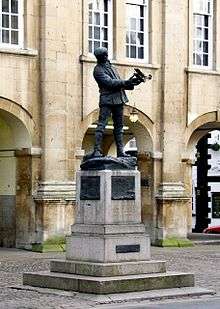Statue of Charles Rolls, Monmouth
A memorial statue to the aviation pioneer Charles Rolls stands in front of the Shire Hall in Agincourt Square, Monmouth, Wales. The 8 feet (2.4 m) high bronze statue was designed by Sir William Goscombe John, R.A.[2] and Sir Aston Webb, R.A. designed the pink granite plinth.[2] The statue is a Grade II* listed structure.[1]
| Statue of Charles Rolls | |
|---|---|
 The statue is in front of Monmouth's Shire Hall | |
| Artist | Sir William Goscombe John, R.A. |
| Year | 19 October 1911 |
| Medium | Bronze |
| Dimensions | 2.4 m (8 ft) |
| Location | Agincourt Square, Monmouth |
| 51°48′43.36″N 2°42′56.27″W | |
Listed Building – Grade II* | |
| Official name | Statue of C S Rolls |
| Designated | 15 August 1974 |
| Reference no. | 2229[1] |
Charles Stewart Rolls was the third son of John Rolls, 1st Baron Llangattock, and his family home was The Hendre to the north of the town,[3] where Sir Aston also designed the Cedar Library.[3] The Rolls family were significant landowners in the nineteenth century and major benefactors to the town and county. The statue was proposed by the Borough Council in June 1910, to celebrate Charles Rolls's two-way crossing of the English Channel.[4] However, Rolls was killed in an accident at an airfield near Bournemouth on the south coast of England the following month.[5] The statue and plaques around the plinth therefore commemorate his life achievements.
The statue was cast by A. B. Burton at the Thames Ditton Foundry,[6] which produced many bronze statues around the world, including the statue of Eros in Piccadilly Circus, and the 38-ton "Peace Quadriga"[7] on Wellington Arch at Hyde Park Corner, London. It was unveiled on 19 October 1911, by Colonel Lord Raglan, C.B., accompanied by a large gathering of dignitaries and the public.[8] Rolls is seen inspecting a purposely incomplete model of his biplane. The tail plane is the missing element on the model, alluding to the cause of the accident which killed Rolls.[4] Shortly before the fatal flight, the tail plane was modified in an attempt to improve control.
The main dedication is all in upper case and reads:
Erected by public subscription to the memory of the Honourable Charles Stewart Rolls, third son of Lord and Lady Llangattock as a tribute of admiration for his great achievements in motoring ballooning and aviation. He was a pioneer in both scientific and practical motoring and aviation and the first to fly across the channel from England to France and back without landing. He lost his life by the wrecking of his aeroplane at Bournemouth July 12, 1910. His death caused worldwide regret and deep national sorrow.
Gallery
 Statue of Charles Rolls, photograph from 1910s
Statue of Charles Rolls, photograph from 1910s Close up
Close up- Rolls inspecting the Wright Flyer
- Plaque celebrating his enthusiasm for motor racing. (Bronze)
- Plaque celebrating his Channel crossing. (Bronze)
 Plaque celebrating his enthusiasm for ballooning. (Bronze)
Plaque celebrating his enthusiasm for ballooning. (Bronze)- Dedication
- Rolls statue 2010 plaque
- Statue Title
- Rolls 1977 Plaque
Notes
- Statue of C S Rolls, Cadw, retrieved 27 April 2020
- Newman, p. 402.
- Newman, p. 407.
- the Hon Charles Stewart Rolls 1877–1910, Air Racing History, accessed February 2012
- Charles Rolls Tragedy at Air Pageant – Famous Aviator Dies, Charles Rolls Memorial Trust
- Public Monument and Sculpture Association, National Recording Project
- British bronze sculpture founders and plaster figure makers, 1800–1980 – T, NPG, accessed February 2012
- Rolls’ statue celebrates it’s [sic] centenary, Monmouthshire Beacon, 20 October 2011, accessed February 2012
Sources
- Newman, John (2000). Gwent/Monmouthshire. The Buildings of Wales. Penguin. ISBN 0-14-071053-1.
External links

- Early Aviators: Charles Rolls